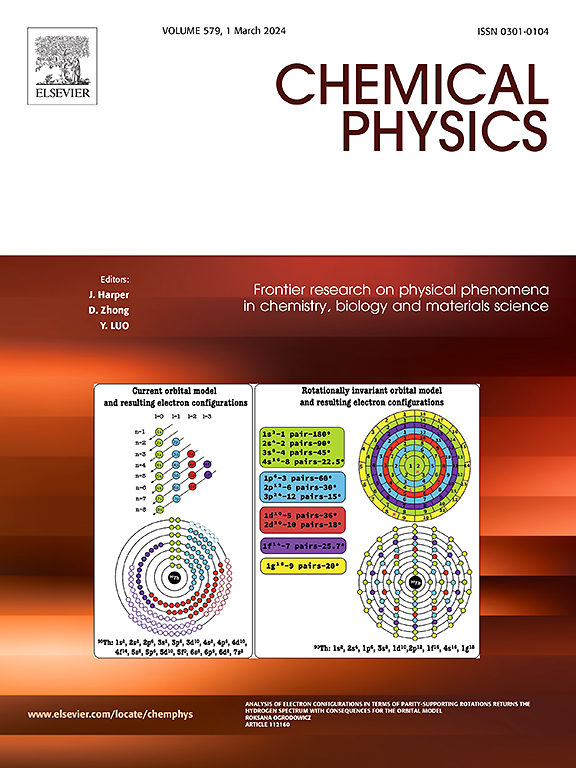具有直接带隙的新型立方硅同素异形体的力学和电子特性:第一性原理计算
IF 2
3区 化学
Q4 CHEMISTRY, PHYSICAL
引用次数: 0
摘要
本文提出了一种立方笼状硅同素异形体,命名为Si96I,属于fd - 3m空间群。采用第一性原理计算,对其结构、力学和电子特性进行了详细的探索和分析。在正常的环境压力条件下,Si96I表现出显著的机械、动力学和热稳定性。与金刚石- si不同,Si96I具有延展性,密度较低,仅为1.409 g/cm3,这可归因于其相对较大的孔隙结构。此外,在弹性力学方面,这种新型硅材料的各向异性比金刚石硅材料的各向异性要小得多。这意味着方向对其弹性模量的影响较小。最重要的是,Si96I被确定为具有0.73 eV的直接窄带隙的半导体,赋予它巨大的潜力,以推动光电工业以及新能源材料领域的未来发展。优越的可见光吸收特性也使其成为下一代太阳能电池的极有希望的候选材料。本文章由计算机程序翻译,如有差异,请以英文原文为准。
Mechanical and electronic properties of a novel cubic silicon allotrope with direct band gap: First-principles calculation
In the present manuscript, a cubic cage-like silicon allotrope, designated as Si96![]() I and belonging to the Fd-3 m space group, is put forward. Employing first-principles calculations, a detailed exploration and analysis of its structural, mechanical, and electronic characteristics were carried out. Under normal ambient pressure conditions, Si96
I and belonging to the Fd-3 m space group, is put forward. Employing first-principles calculations, a detailed exploration and analysis of its structural, mechanical, and electronic characteristics were carried out. Under normal ambient pressure conditions, Si96![]() I demonstrates remarkable mechanical, kinetic, and thermal stabilities. Distinguishing itself from diamond-Si, Si96
I demonstrates remarkable mechanical, kinetic, and thermal stabilities. Distinguishing itself from diamond-Si, Si96![]() I exhibits ductility and possesses a notably low density of 1.409 g/cm3, which can be attributed to its relatively large pore structure. Furthermore, in terms of elastic mechanics, the anisotropy of this novel silicon material is found to be less significant than that of diamond silicon. This implies that the direction has a lesser impact on its elastic modulus. Most importantly, Si96
I exhibits ductility and possesses a notably low density of 1.409 g/cm3, which can be attributed to its relatively large pore structure. Furthermore, in terms of elastic mechanics, the anisotropy of this novel silicon material is found to be less significant than that of diamond silicon. This implies that the direction has a lesser impact on its elastic modulus. Most importantly, Si96![]() I is identified as a semiconductor with a direct and narrow band gap of 0.73 eV, endowing it with great potential to fuel future advancements in the optoelectronic industry as well as in the realm of new energy materials. The superior visible light absorption characteristics also make it a highly promising candidate material for next-generation solar cells.
I is identified as a semiconductor with a direct and narrow band gap of 0.73 eV, endowing it with great potential to fuel future advancements in the optoelectronic industry as well as in the realm of new energy materials. The superior visible light absorption characteristics also make it a highly promising candidate material for next-generation solar cells.
求助全文
通过发布文献求助,成功后即可免费获取论文全文。
去求助
来源期刊

Chemical Physics
化学-物理:原子、分子和化学物理
CiteScore
4.60
自引率
4.30%
发文量
278
审稿时长
39 days
期刊介绍:
Chemical Physics publishes experimental and theoretical papers on all aspects of chemical physics. In this journal, experiments are related to theory, and in turn theoretical papers are related to present or future experiments. Subjects covered include: spectroscopy and molecular structure, interacting systems, relaxation phenomena, biological systems, materials, fundamental problems in molecular reactivity, molecular quantum theory and statistical mechanics. Computational chemistry studies of routine character are not appropriate for this journal.
 求助内容:
求助内容: 应助结果提醒方式:
应助结果提醒方式:


